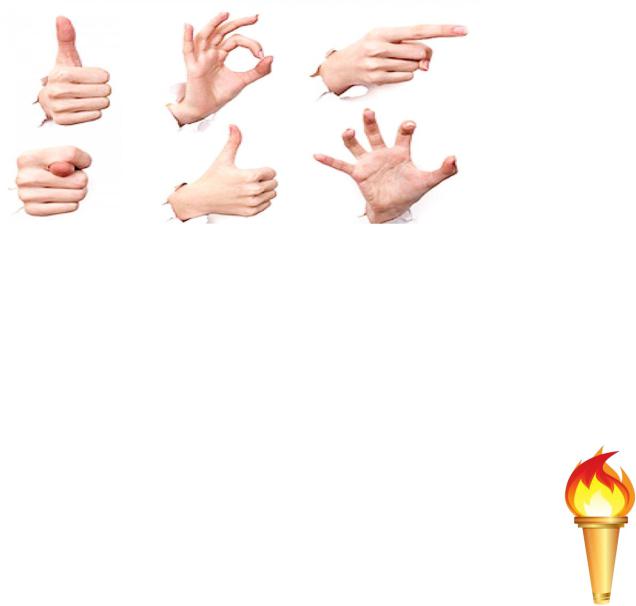
Методическое пособие 651
.pdf
McDonald’s or Coca-Cola as examples of tastes, markets and hence cultures becoming similar everywhere. There are, indeed, many products and services becoming common to world markets. What is important to consider, however, is not what they areandwheretheyarefoundphysically,butwhattheymeantothepeopleineachculture.
The essence of culture is not what is visible on the surface. It is the shared ways groups of people understand and interpret the world. So the fact that we can all listen to Walkmans and eat hamburgers tells us that there are some novel products that can be sold on a universal message, but it does not tell us what eating hamburgers or listening to Walkmans means in different cultures. Dining at McDonald’s is a show of status in Moscow whereas it is a fast meal for a fast buck in New York. If business people want to gain understanding of and allegiance to their corporate goals, policies, products or services wherever they are doing business, they must understand what those and other aspects of management mean in different cultures. In addition to exploring why universal applications of western management theory may not work, we will also try to deal with the growing dilemma facing international managers known as “globalization”.
As markets globalize, the need for standardization in organizational design, systems and procedures increases. Yet managers are also under pressure to adapt their organization to the local characteristics of the market, the legislation, the fiscal regime, the socio-political system and the cultural system. This balance between consistency and adaptation is essential for corporate success.
Source: Reading the Waves of Culture. [Электронный ресурс]. – Режим доступа: URL: https://pdfs.semanticscholar.org/baa5/8e86493834d21459cba14437d8900542d666.pdf (время обращения - 23.08.18).
Task 4. Match Russian and English equivalents:
1. |
solutions |
a) |
условия |
2. |
truth |
b) |
продвижение |
3. |
circumstances |
c) |
объекты |
4. |
rule |
d) |
решения |
5. |
promotions |
e) |
отчетность |
6. |
premises |
f) |
правило |
7. |
accountability |
g) |
по всему миру |
8. |
worldwide |
h) |
правда |
Task 5. Connect the sentences so that they make sense:
1. |
Many products and services |
a) |
may not be shared |
2. |
Some cultural biases |
b) |
study up-to-date management philos- |
|
|
ophies |
|
3. |
Common culture worldwide |
c) |
become common worlds service |
4. |
Many modern managers |
d) |
is based on the rules of reward and |
|
|
promotion |
|
5. |
Pay-for-performance philosophies |
e) |
would make the life of international |
|
|
managers much simpler |
|
|
|
50 |
|
Task 6. Match the sentences as True or False:
1.Modern managers philosophies perform universal solutions.
2.International managers must combine many different premises.
3.Commonculturebiaseswillmakethelifeofinternationalmanagersreallydifficult.
4.The location of products and services is the essential factor in the process of internationalization.
5.One of the most difficult tasks of international management is to adapt their organization to the local needs and their cultural features.
Task 7. Answer the following questions:
1. Why may most modern management theories not work in some continents?
2.In what phenomena may different cultures be special?
3.What effect can common culture have worldwide?
4.Whatexamplesofsomeproductsinterpretationindifferentcountriescanyougive?
5.What dilemma do international managers face?
6.What aspects must managers take into account to adapt their organization to the localneeds?
Task 8. Complete the text with the following phrases. There are three extra phrases that you don`t need to use:
a)your international business developments;
b)to switch off;
c)setting high price for your products.
d)a business culture will encompass;
e)firms and organizations;
f)to switch on;
g)from accounting to production;
i) values and activities.
Business Culture
Culture illustrates the accepted norms and values and traditional behaviour of a group. One definition of culture by Deal and Kennedy (corporate culture researchers) is “the way a we do things around here”. However, culture also evolves over time. The culture of each country has its own beliefs, 1) … . In other words culture can be defined as an evolving set of collective beliefs, values and attitudes.
Culture is a key component in business and has an impact on the strategic direction of business. Culture influences management, decisions and all business functions 2) …. You may now be thinking predominantly about national culture but this is only one aspect, business culture is its own unique dimension that includes getting off on
51
the right foot, meetings, negotiation, formalities, social media use, internships and work placements and other elements.
Business culture is related to behaviour, ethics, etiquette and more. 3) … as organisation’s values, visions, working style, beliefs and habits.
Although you will find that each country has a number of individual characteristics, belowaresomeofthemainbusinessetiquettetraditionswhichshouldhelpyouin4)…:
Be aware of any differences between the host country and your own and try to fit in with their business culture.
Never forget to say ‘Thank You’ whether you are at job interview or client meeting.
Be polite and don’t discuss the meeting straight away as soon you step out of the meetingroom.
Always remember 5) … or put on silent your phone in a meeting to avoid distraction.
If you disagree with something instead of criticising try to understand the other person’s point of view and never lose your temper.
Always be honest about whatever you are saying.
Source: Passport to Trade. [Электронный ресурс]. – Режим доступа: URL: https://businessculture.org/business-culture/ (время обращения – 18.07.2019).
Task 9. Match the sentences below as true or false:
1.Culture undergoes changes over time.
2.Culture is an individual characteristic of a person.
3.Business culture is a separate aspect of national culture.
4.Each country has unique national characteristics.
5.Don`t hesitate to express your own opinion about any topic that you like.
6.It is important to know and respect the differences between the cultures of any countries.
7.Culture doesn`t make any influence on business.
Task 10. Choose the sentence that better summarises the text in Task 8:
1.Culture differences play important role in business because it influences all aspects of business of any country.
2.You should follow business etiquette tradition of a country where you work.
3.There are individual and general business characteristics.
Task 11. Write down the summary for the text in Task 8. Use the following expressions:
The text presents the idea of …
52
There is information about …
It is necessary to say that …
Firstly, … Secondly, … Also, …
To conclude, …
Task 12. Read the information below about two different management styles, determined as Management in Culture A and management in Culture B. Match the sentences 1-5 below as True or False. Prove your choice.
Culture A |
Culture B |
Plan for every solution with a boss |
Develop a plan, then ask boss to agree |
Create department hierarchy |
Organize department into teams |
Prefer to communicate face-to-face |
Prefer to communicate via e-mail |
Inform subordinates about decisions |
Involve subordinates about decision- |
|
making |
Emphasize financial results in evaluat- |
Focus on customers satisfaction in eval- |
ing performance |
uation |
1.This culture is more flexible.
2.This culture is more modern.
3.The manager in this culture is more directive.
4.Subordinates help in desicion-making.
5.If finance is the main factor in decision-making, staff are happy.
Source: Simon Sweeney. Series Eddition: Nick Brieger. Professional English Management, 2-nd imprssion 2002, First Published 2002, Pearson Education Limited, Edinburg Gate, Harlow, Essex CM20 2JE, England. Section 1. Unit 7.
Task 13. Look at the issues below. Which phenomenon is related to the CULTURE of a company (C), to the ORGANIZATION of a company (O) or BOTH (B)? Match the statements as C, O or B:
1.Values.
2.Benefits.
3.Having a clear structure.
4.Customs and traditions.
5.Beliefs.
6.Sources for authiruty.
7.Ethic norms.
8.Objectives and common purposes.
9.Relations between center and periphery
10.Shared experience
11.The system of relations
12.Dreess code
53

Source: Simon Sweeney. Series Eddition: Nick Brieger. Professional English Management, 2- nd imprssion 2002, First Published 2002, Pearson Education Limited, Edinburg Gate, Harlow, Essex CM20 2JE, England. Section 3. Unit 17.
Task 14.
a)Read the proverb below. What does it mean? Do you agree/disagree with it? Prove your opinion.
When in Rome do as the Romans do.
b)Look at the jestures a-f below. What do they mean? Do they imply something positive/negative/neutral in your native country?
a |
b |
c |
d |
e |
f |
Source: Яндекс, [Электронный ресурс]. – Режим доступа: URL: https://www.yandex.ru/search/?text=hfpyst%20%3Btcns%20rfhnbyrf&rdrnd=688314&lr=213&redircnt=156 5476329.1 (время обращения – 11.08.2019).
c) Conduct the research on cultural differences between: 1) European countries, 2) Asian Countries.
Culture and Business in Action
a)Imagine that you are business culture expert. You need to consult international businessman about dealing with Russian companies. What are the most essential aspects of doing business in Russia?
b)Do you know any curious cases when difference in business culture led to unexpected results? Share this information with the class.
54

UNIT 10
BUSINESS PLAN
Task 1. Discuss the following questions:
1.What aspects do you need to consider when starting a business?
2.Who may need a business plan of a company?
3.Are you good at planning? What aspects are more difficult to represent?
Task2.Readand memorizethewordsbelow thatwillhelpyouunderstandthetext.
1.executive [ɪɡˈzɛkjʊtɪv] – руководитель
2.loan application [ləʊn ˌæplɪˈkeɪʃən ] - заявка на получение кредита
3.lender [ˈlendəʳ] - кредитор
4.venture [ˈvɛntʃə] - предприятие
5.road map - дорожная карта (план действий; ориентиры)
6.entrepreneur [ɒntrəprəˈnɜː ] - предприниматель
7.limitation [ˌlɪmɪˈteɪʃən ] – ограничение
8.virtually [ˈvɜːtʃʊəlɪ ] – практически, фактически
9.clarify [ˈklærɪˌfaɪ ] – изъяснять, прояснять
10.intend [ɪnˈtɛnd ] - намереваться
11.to head [hɛd] - возглавлять
12.tailor [ˈteɪlə ] - приспосабливать
13.audience [ˈɔːdɪəns] – публика, аудитория
14.blueprint [ˈbluːˌprɪnt] - план, программа
15.performance [pəˈfɔːməns] - выполнение
16.measure [ˈmɛʒə] – определять, измерять
17.expenditure [ɪksˈpɛndɪtʃər] - траты
18.adjust [əˈdʒʌst ] - приспосабливать
19.requirement [rɪˈkwaɪəmənt] - требование
20.overall [ˈəʊvərˌɔːl ] – общий, полный
21.authoritative [ɔːˈθɒrɪtətɪv] - авторитетный
22. contingency plan [kənˈtɪndʒənsɪ] - чрезвычайный план
(предопредел нный план действий в аварийных ситуациях, включающий в себя процедуры резервного копирования и подготовку резервного оборудования для преодоления чрезвычайной ситуации)
23.thoughtful [ˈθɔːtfʊl] – глубокомысленный, внимательный
24.charts [tʃɑːt] – таблица, диаграмма, схема
25.schedule [ˈʃɛdjuːl] – расписание
55
26. executive summary - (рабочее) резюме, основные положения; пояснительная записка (преимущественно для руководства)
Task 3. Read and translate the text.
Why a Business Plan is Important?
A company's business plan is one of its most important documents. It can be used by managers and executives for internal planning or as the basis for loan applications from banks and other lenders. For start-up ventures, the process of preparing a business plan serves as a road map to the future by making entrepreneurs and business owners think through their strategies, evaluate their basic business concepts, recognize their business's limitations, and avoid a variety of mistakes.
Virtually every business needs a business plan. Business plans help companies identify their goals and objectives and provide them with tactics and strategies to reach those goals. "By its very definition, a business plan is a plan for the business, clarifying why it exists, who it exists for, what products and services it provides these client groups, how it intends to develop and deliver these products and services, and where it is headed," Rebecca Jones wrote in Information Outlook.
While business plans have elements common to all uses, most business plans are tailored according to their specific use and intended audience. When used for internal planning, business plans can provide a blueprint for the operation of an entire company. A company's performance and progress can be measured against planned goals involving sales,expenditures,time frame, and strategic direction.
Business plans also cover such areas as marketing opportunities and future financing requirements that require management attention. Ideally, everyone in the company will use the information contained in the company's business plan. Workers who are informed about the business plan can evaluate and adjust their own performance in terms of company objectives and expectations.
Successful business plans are usually the result of team effort, in which all employees provide input based on their special areas of expertise and technical skill. Business owners and managers provide overall support for the planning process as well as general guidelines and feedback on the plan as it is being developed.
Business plans must include authoritative, factual data, usually obtained from a wide range of sources. Problems and risks associated with the business should be described rather than avoided, then used as the basis for presenting thoughtful solutions and contingency plans.
Business plans contain a number of specific elements as well as certain general characteristics. These include a general description of the company and its products or services, an executive summary, management and organizational charts, sales and marketing plans, financial plans, and production plans. The major elements found in business plans are: executive summary of entire business plan, description of business, description of products and/or services, description of management and organi-
56
zational structure, market analysis, sales and marketing plan, production plan, financial plan, implementation schedule, contingency plans, etc.
Source: Reference for Business, [Электронный ресурс]. – Режим доступа: URL: http://www.referenceforbusiness.com/small/Bo-Co/Business-Plan.html (время обращения – 17.08.2017).
Task 4. Match the verbs to their definitions:
1. clarify |
a. to make (something) available |
2. tailor |
b. to make understandable |
3. provide |
c. to cause (something) to grow or become bigger or more ad- |
|
vanced |
4. avoid |
d. to make (someone or something) a part of something |
5. develop |
e. to prevent the occurrence of (something bad, unpleasant, etc.) |
6. include |
f. to study (something) closely and carefully |
7. manage |
g. to make or change (something) so that it meets a special need or |
|
purpose |
8. analyze |
h. to have control of (something, such as a business, department, |
|
sports team, etc.) |
Task 5. Fill in the gaps with the word of phrase below:
major elements, marketing opportunities, start-up venture, successful plans, performance, loan applications, blueprints,
1.The … … of China National Petroleum resulted in their inclusion in the List of the Largest Companies by Revenue.
2.The newly developed … of many bakeries is to sell their products 50% cheaper if they haven`t been bought on the day of their production. It resulted in much greater profit and turnover.
3.Let`s enlist three … …. of successful business: well-developed plan, responsibility of management and stable profit.
4.Theannualreportrepresentscompany`s…andprospectsforthefutureinvestors.
5.To get … … is possible if a company represents their activity in a consistent form - business plan and provide in to the bank.
6.All the … of the future plan were thoroughly checked by the executive before the overall documentation was prepared.
7.The participants of the young people`s forum were offered the opportunity to
…their own … .
57
Task 6. Translate the following sentences into English:
1.Бизнес-план компании – это важный документ, который помогает оценить основные установки и цели бизнеса.
2.Бизнес-план также создается для внутреннего пользования всеми сотрудниками компании.
3.Дорожная карта – это стратегия развития, определяющая цели фирмы на ближайшее будущее.
4.Для того чтобы оценить и адаптировать свою работу в компании, работники должны знать о е целях и перспективах.
5.Владельцы компании осуществляют общее руководство составлением бизнес-плана.
6.Помимо информации о растратах и прибыли, бизнес-план должен включать данные о возможных рисках и проблемах, а также чрезвычайный план.
7.Важным элементом бизнес-плана является схемы по управлению и организации на предприятии.
Task 7. a) Give the synonyms to the following words: to head, documents, venture, product, blueprint, usually, thoughtful, chart, major, team.
b) Find 7 pairs of synonyms in the text. e.g.: goals – objectives.
Task 8. Answer the following questions:
1)What is business plan?
2)Whom is it usually presented to?
3)Who usually takes part in making business plan?
4)In what way can business plan be used by the company members?
5)What does business plan usually include?
6)Should problems and risks associated with the business be included in a business plan?
7)What usually influences the contents of the business plan?
Task 8. To make a business plan the data of SWAT analysis is used (SWAT – Company`s Strength, Weaknesses, Opportunities and Threats). Look at the points below that represent thefindings oftheSWATanalysis of GUBUToys LTD. Putthepointsinthe correct boxbelow:
1.Reliable and committed workforce.
2.Use of wood – seen as “good for environment”.
3.High labour costs.
4.Location – far from population centers/far from new markets.
5.Beautiful handmade toys.
6.Poor communications systems/limited technological schemes.
58

7.Internet as potential marketing tool/e-commerce.
8.Lack of IT training in staff.
9.Declining interest in domestic markets for traditional toys.
10.Potentially strong demand in Germany and Scandinavia.
11.Competition in Germany and Scandinavia/Baltic countries.
12.Increased competition from mail order companies.
13.Selling by new channels, e.g. mail order.
14.R&D department is constantly searching for new materials and designs.
Expo Marketing Consultants
SWAT Analysis for Gubu (Toys) Ltd
Strength |
Weaknesses |
1 |
|
|
|
Opportunities |
Threats |
|
|
Source: Simon Sweeney. Series Eddition: Nick Brieger. Professional English Management, 2-nd imprssion 2002, First Published 2002, Pearson Education Limited, Edinburg Gate, Harlow, Essex CM20 2JE, England. Section 6. Unit 39.
Business Plan in Action
Think of a business you would like to start. What sector would it be connected with? Think over the business plan of your company and present it to the class.
UNIT 11
CORPORATE CULTURE
Task 1. Discuss the following questions:
1.What are advantages and disadvantages of managing a multinational company?
2.What companies that you know are multination-
al?
3.What company would you like to work for:
monoor multinational? Why?
59
